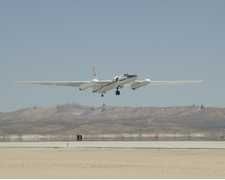Back to Explore
ALASKA-95
Atmospheric Composition, Carbon Cycle & Ecosystems, Global Water & Energy Cycle
- 1
- view all deployment datesDeployment
1995-03-31 1995-04-25 - 1
- Platforms
- 0
- Data Products
The Campaign
1995-03-31 — 1995-04-25
Central to Northern Alaska & Bering Sea
boreal spring
N: 72°N
S: 50°N
W: 178°W
E: 138°W
no campaign DOI available
Additional Notes
Repositories
other NASA repository not formally considered a DAAC by ESDS
SEA ICE
SNOW
CLOUDS
VEGETATION TYPE
Slide 1 of 1

NASA Earth Resources-2 Aircraft
62 Campaigns · 107 Instruments
The Cloud Lidar System (CLS) was an airborne lidar system that operated on the ER-2 aircraft. It measured lidar backscatter to determine the height structure of clouds, cloud thickness, and other cloud properties. CLS was also used to determine aerosol properties. It used a Nd-YAG operating at 1064 and 532 nm and had a pulse repetition frequency of 10 Hz. CLS had a horizontal resolution of 20 m and a vertical sampling resolution of 7.5 m.
Earth Science > Atmosphere > Clouds
Earth Science > Atmosphere > Aerosols
Earth Science > Spectral/engineering > Lidar > Lidar Backscatter
Earth Science > Atmosphere > Clouds > Cloud Properties
Earth Science > Atmosphere > Aerosols > Aerosol Optical Depth/thickness
Earth Science > Atmosphere > Aerosols > Aerosol Backscatter
Earth Science > Atmosphere > Clouds > Cloud Microphysics > Cloud Optical Depth/thickness
The Aerodynamic Particle Sizer (APS) is an in situ spectrometer manufactured by TSI Instruments. APS measures aerodynamic particles in the 0.5-20 μm size range. It also measures the light-scattering intensity of the particles in the 0.37-20 μm optical size range. APS provides particle size distributions for 52 channels at a typical sampling time of 1 second. It uses a laser diode operating at 655 nm and has a size resolution of 0.02 μm at 1 μm. APS can be deployed on aircraft, ships, or ground-based platforms.
Earth Science > Atmosphere > Clouds > Cloud Microphysics > Particle Size Distribution
Earth Science > Atmosphere > Aerosols
Earth Science > Atmosphere > Aerosols > Aerosol Particle Properties
The MODIS Airborne Simulator (MAS) is an airborne multispectral spectrometer designed to simulate the satellite instrument Moderate-Resolution Imaging Spectrometer (MODIS). MAS operates across 50 spectral channels in the 0.55 to 14.2 μm range to provide high-resolution imagery of clouds and surface features. MAS has a horizontal spatial resolution of 50 m and a swath width of about 36 km at an altitude of 20 km at nadir. It has a scan rate of 6.25 Hz with each scan line containing 716 pixels.
Earth Science > Atmosphere > Atmospheric Radiation
Earth Science > Spectral/engineering > Visible Wavelengths > Visible Imagery
Earth Science > Spectral/engineering > Infrared Wavelengths > Infrared Imagery
Earth Science > Spectral/engineering > Visible Wavelengths > Visible Radiance
Earth Science > Spectral/engineering > Infrared Wavelengths > Infrared Radiance
The Scanning High-resolution Interferometer Sounder (S-HIS) is an airborne cross-track scanning interferometer developed by the Space Science and Engineering Center at the University of Wisconsin-Madison. It measures the emitted thermal radiation between 3.3 and 18 microns at high spectral resolution. These measurements can be used to derive atmospheric profiles of temperature and water vapor in clear-sky conditions. S-HIS has a spatial resolution of 2 km and a swath width of 40 km at an altitude of 20 km at nadir. It has a sampling frequency of 0.5 s and an absolute radiance accuracy of 0.2 K.
Earth Science > Atmosphere > Atmospheric Water Vapor > Water Vapor Profiles
Earth Science > Atmosphere > Atmospheric Temperature
Earth Science > Atmosphere > Atmospheric Radiation > Atmospheric Emitted Radiation
Earth Science > Atmosphere > Atmospheric Water Vapor
The Millimeter-wave Imaging Radiometer (MIR) was a passive airborne cross-track scanning radiometer developed by NASA. MIR measured brightness temperature across nine channels and was used for clouds, precipitation, and atmospheric water vapor studies. MIR operated near and around the following frequencies: 89, 150, 183, 220, and 325 GHz. It had an angular swath of 100 degrees and a sampling frequency of 3 seconds. MIR typically operated on NASA ER-2 aircraft before its retirement.
Earth Science > Spectral/engineering > Infrared Wavelengths > Brightness Temperature
Earth Science > Atmosphere > Precipitation
Earth Science > Spectral/engineering > Microwave > Brightness Temperature
Earth Science > Atmosphere > Clouds
Earth Science > Atmosphere > Atmospheric Water Vapor
Events
1 Deployment
1 IOP
NASA
Currently unavailable
Currently unavailable
Dorothy Hall
Currently unavailable
Currently unavailable
Currently unavailable